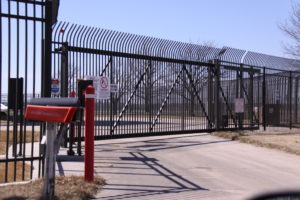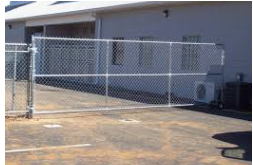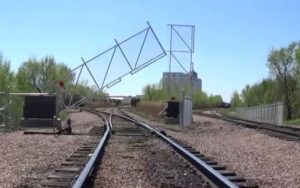
Many a customer has said after their fence was installed, “I wish I would have gone with a …..gate instead.” America’s Gate Company staff are trained professionals within the fencing industry. As professionals, we are obligated to point out the features, benefits, and liabilities of each type of gate installation. On the surface, it may be obvious what is the best gate selection for your site until your gate is installed and you discover it does not open a full ninety degrees or slide uphill. Here are some frequently asked questions we see that will hopefully help you to determine which gate is right for you.
Single or Double Gate – Which Should You Choose?
Swing gates are the most widely used gates within our industry. These gates come in both single and doubles. Why use a double versus a single? The obvious answer may be the size of the opening. That would not be necessarily correct. The selection of a single versus double has more to do with the following:
- The slope that runs parallel to the fence line or gate opening. If there is too much slope that a single gate hung plumb while closed will have a gap of the bottom of the gate that is greater than six inches at one end; a double gate should be considered to divide that gap between the two leaves.
- The swing of the gate and slope that runs perpendicular to the fence line or gate opening. If a single gate when swung open bottoms-out against a rising slope; a double gate should be considered to hopefully prevent the gate from bottoming-out. A double swing gate will have two leaves that will be half as long as a single leaf that fills the opening. It must be said here that rarely do we recommend a drive gate that swings out into the outside, public side, of the fence. In general, when you swing a drive gate out; you may cause those outside the gate to back-up to allow for the gate to open. This may cause them to back-up into traffic. Imagine a driver that is sitting at the entrance of a gated community. Behind him is a busy perpendicular thoroughfare with speeding traffic. The gate begins to open out toward the driver. The driver panics and puts his car into reverse. Paying more attention to the oncoming gate, the driver fails to recognize the on-coming traffic he has now backed into. Crash!
- The storage of the gate. If a single gate results in storing the gate into a drive lane or parking stall; a double swing gate will only take up half as much storage space.

On the surface, it may appear that a double drive gate is always a safer install. It may appear so but we believe a single gate is a much safer and reliable installation. A single gate is secured, locked, to a positive immovable latch post whereas a double drive swing gate is secured at the end of the two panels where these meet in the middle. A double drive swing gate uses a drop rod assembly that is installed between the two leaves and pins the gate leaves to the ground. This is not as secure as a single swing gate that uses a latch post set into a concrete footing.
When does the opening get to be too large for a single gate leaf? All of the above aside, it would take a very wide opening to not consider a single leaf. America’s Gate Company has successfully built sixty foot plus single swing gate leaves.
Regardless if you use a single swing gate or a double drive swing gate, American’s Gate Company recommends the use of our Ultra Latch. The American Ultra Latch is the only non-removable no-cut padlock gate latch in the industry. It is available in both a single swing gate and double drive gate install.
Why would I want to use an overhead track gate?
Large overhead track slide gates make good sense when you have a heavy use facility entrance and need a highly reliable slide gate. Because these gates do not need a counter balance like a cantilever slide gate; these gates place far less stress on the gate hardware and gate operators. These gates also use heavy duty hardware that is designed for continuous duty with very little wear and tear. Because these gates have a track that extends above and through the opening; the gate is far more rigid under high winds and severe weather conditions.
These gates use a large 6” or 8” I-Beam that spans over the opening and travels long enough to support the gate in the full opening. This I-beam is the gate track. It borrows a trolley design from the material handling industry to support the gate along this I-beam track. These trolleys are often times rated for several thousands of pounds and use high quality sealed bearings. Depending on the gate opening, two to three trolleys will more than adequately support the weight of the gate. The I-beam track is placed at such a height to accommodate truck traffic which is limited to 14’ overall clearance unless a special over-height permit is obtained.
The gate frame may be aluminum or steel. The gate panel is typically the same height as the adjoining fence. It is extended to the height of the track with vertical uprights and attached to the trolleys. Though overhead track slide gates do not require a counter balance; the rear of the gate must be slightly extended if the gate is to be automated. This is necessary to extend the gate operator chain beyond the gate operator. Large overhead slide gates are an excellent choice for high-speed automation needed in secure facilities and airports. With the large rigid track extended above and through the opening, this prevents the gate from bouncing up and down due to the torque of the gate operator.
When is a rolling gate my best option?
A rolling gate is a type of slide gate. The most popular slide gate is a cantilever gate. Cantilever slide gates use rollers that are attached to support posts with no rollers or wheels touching the ground. The cantilever slide gate is cantilevered over the opening. It is the perfect option for automation as it does not come in contact with the ground and operates easily under adverse weather conditions. Its travel is controlled entirely by the rollers that guide it. Check out our extensive guide on selecting your perfect cantilever gate.
Unfortunately, cantilever slide gates are typically elevated off the ground due to guide wheels and rollers placed underneath the gate frame to support it. Cantilever slide gates must be installed level. Not only is this required in accordance with ASTM 2200; it is critical relative to providing a safe installation. Cantilever slide gates are generally very heavy and roll freely with the use of sealed ball bearing rollers. A slight slope in the gate can cause it to take-off as it rolls downhill. This can create a very deadly situation if the gate were to hit a pedestrian. The elevations under the full travel of the gate must be evaluated when considering a cantilever gate. If the elevations at any point of the travel of the gate are greater than the elevation at the gate support posts; the gate must be raised to maintain a level installation and not bottom-out during travel. For these reasons, cantilever slide gates are not a good option when you have rising slopes and valleys in the travel of the gate.
If your opening is sloped across the opening or if you have a rising elevation on the side the opening where the gate is to be stored; your best option is a rolling slide gate. Rolling gates use rear guide wheels attached to the gate that run on a track attached to the adjoining fence or series of support posts. The track will follow the slope or rising elevation thus the gate will also follow this slope as it travels along the track. At the front of the gate is a wheel assembly. This assembly is located at the bottom of the gate and travels on the ground across the opening. Thus, if your opening slopes the gate will travel with the slope as it opens or closes. With the combination of the rear guide wheels and front wheel assembly, the gate will travel through a sloped opening and will open and rise with a rising elevation.
Unfortunately, rolling gates are not a good option for automation. With the wheel assembly traveling on the ground; variations in slope, ground conditions and severe weather can affect the travel thus making the final destination unknown. A rolling gate should be opened and closed by human contact that controls the direction of the gate when closing and overcomes site or weather conditions.
Rolling gates use a wide range of hardware that includes a front wheel assembly or double wheel carrier, locking device, rear wheels assemblies and track brackets. Installation and the cost of the hardware make a rolling gate not as a competitively priced as a swing gate but slightly less than a cantilever gate.
Why are cantilever slide gates the best choice for automation?
Cantilever slide gates are a very popular choice for gates that require automation. A typical cantilever slide gate is suspended above the ground and through the opening, thus there are no concerns regarding road conditions, changes in terrain or adverse weather. The gates upper and lower guide rollers guide the gate through the opening. Unlike the sweeping effects of single and double swing gates, cantilever slide gates move back and forth. Thus concerns over moderate or even significant levels of snowfall are not an issue for cantilever slidegates.
Cantilever slide gates’ biggest challenge is changing elevations. A cantilever gate is supported by two large support posts on the storage side of the gate opening. The two large support posts support the cantilever rollers or enclosed track trucks that support the gate. The posts are set approximately half the distance of the opening apart from one another. So, if you have a 30’ opening, the posts are 15’ apart. The elevation at these posts must be the highest elevation along the entire travel distance of the gate. Whether manual or automated, cantilever slide gates must be installed level to avoid creating any possibility of harm to others or damage to vehicles. This is a very good practice and in accordance with ASTM 2200 and UL325. A cantilever gate should not be adjusted to changing elevations. If the elevation drops through the opening; there may be a considerable space under the gate. If the elevation along the travel of the gate significantly rises higher than at the support posts’ elevation; the gate may quickly bottom-out while traveling closed or open.
Cantilever slide gates are an excellent choice for storage issues. The gate takes up little space as it stores up against an adjoining fence line. Unlike a large swing gate where you must keep the entire area clear where the gate sweeps closed or open; a cantilever slide gate has a very small footprint. A cantilever gate’s overall length is usually one and a half the distance of the opening. So, if you have a 30’ opening; your gate is 45’ overall. You must account for this space along the fence where the gate stores.
Steel cantilever slide gates that use an all tubular steel frame where the top and bottom horizontal frame members are also the track of the gate. The gate is captured between two bottom and top rollers. Roller covers must be installed to protect others in accordance with ASTM 2200 and UL325. Aluminum cantilever slide gates use an aluminum square frame with an extruded track at the top. Trucks or trolleys are installed so that the trucks run inside the track to support the gate from the support posts. At the bottom, there are two guide wheels that keep the gate plumb and centered. Steel cantilever gates are very reliable and economic. Aluminum cantilever gates are definitely lighter, the rollers are enclosed and a great platform for an ornamental look. The enclosed track system is a much smoother operation during snow and ice storms.
America’s Gate manufactures several hundred cantilever gates every year. Many of these are automated. In today’s high-security society, there are automated systems that will quickly move these cantilever gates at anywhere from 2’ to 11’ per second. Imagine closing a 40’ opening in under four seconds. Automated cantilever slide gates move at 1’ per second. A standard speed for cantilever slide gate operators. Cantilever slide gates are a perfect choice high-end estate entrances, manufacturing facilities, and security applications.
When should I consider a vertical pivot gate?
Do you need the ultimate solution in removing any gaps at the bottom of your gate? Do you not have the storage space for a rolling, cantilever or swing gate? Your solution may be a vertical pivot gate.
Vertical pivot gates are light weight gates that operate on a single pivot point that is located on one side of the opening. The gate pivots by lifting and vertically spinning on a single located at the base of the opening. To accomplish this opening and closing, the gate requires a gate operator. These operators are specific to the gate and designed to work together. The gate operator uses a highly tensioned spring and hydraulic cylinder to open the gate. When activated, the spring pulls the gate back and up. The hydraulic cylinder controls the motion. When closing, the cylinder pushes up and forward, tensioning the spring.
Because vertical pivot gates practically lift straight up, the gate frame can be designed to meet the terrain of the ground below the gate. This makes these gates very popular with installations that require one hundred percent closure or no gaps such as airports and military bases. Vertical lift gates have also become very frequent on railroad installations. Railroad tracks are placed on a thick base of ballast. This creates a very convex and irregular contour through the gate opening. Vertical lift gates have been fabricated to not only mirror the ballast but to work in and over the tracks, leaving less than a four-inch gap.
Vertical pivot gates require less than ten feet of storage space along the gate opening. This is often less than half of the actual gate opening, unlike a cantilever slide gate that requires almost one and half times the opening for storage. This also makes vertical pivot gates very practical for tight downtown parking lots.
In areas of the country that receive a great deal of adverse weather and are remote enough that the gates are not regularly maintained, vertical pivot gates have become very popular. On ranches and farms, these gates are an excellent choice when placed on solar power as these gates require little electrical demand with the hydraulic cylinder and offsetting spring gate operator installation. Vertical pivot gates do not slide or sweep, thus are not pushing snow when opening or closing.
The downside to this type of gate installation is the considerable footing required to support the gate operator. This footing is the anchor for the system that presents a great deal of stability and lifting and lowering the gate. There is also a much greater cost with a vertical pivot gate installation. The gate operator is very large and its components are much more significant than a standard slide gate operator and the gate is engineered and fabricated to work with the operator’s components.



